

Trop rares bonnes nouvelles. Mammifères (nos frères) Oiseaux. Insectes. Amphibiens. Abeilles et apiculture (Questions, Réseaux & applications) La population de poissons migrateurs a baissé de 76 % depuis 1970 Le 29 juillet 2020. Les poissons migrateurs ont vu leur population diminuer en moyenne de 76 % entre 1970 et 2016.

C’est ce qu’indique un rapport du WWF, l’UICN et de la World fish migration foundation publié mardi. En cause : la dégradation des habitats et la surpêche. Le commerce des espèces menacées en 4 graphiques Why Did Millions Of Ladybugs All Migrate At Once? What at first appeared to be a rain cloud above Southern California on the National Weather Service’s (NWS) radar June 4 turned out to actually be a huge swarm of ladybugs flying south.
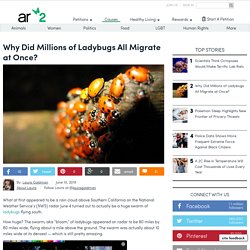
How huge? The swarm, aka “bloom,” of ladybugs appeared on radar to be 80 miles by 80 miles wide, flying about a mile above the ground. The swarm was actually about 10 miles wide at its densest — which is still pretty amazing. Be an informed activist. Déclin de la biodiversité: Du faux sang coule au Trocadéro. 8 Endangered Species You've Never Heard Of. Some endangered species get a lot of fanfare.

Many of us know about the various species of tigers, leopards and whales that are in serious danger of going extinct. Protecting these species is absolutely important. But what about the endangered species that fly under the radar? Du zèbre, de l'autruche et du kangourou au rayon viande des supermarchés français - 20minutes. 10 Animals That Have Gone Extinct In The Last 100 Years. Nearly 500 species have gone extinct during the last century–and in most cases, we humans are to blame.
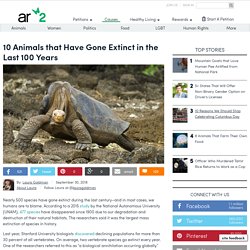
According to a 2015 study by the National Autonomous University (UNAM), 477 species have disappeared since 1900 due to our degradation and destruction of their natural habitats. The researchers said it was the largest mass extinction of species in history. Last year, Stanford University biologists discovered declining populations for more than 30 percent of all vertebrates. On average, two vertebrate species go extinct every year. One of the researchers referred to this as “a biological annihilation occurring globally.”
These are just some of the animals that have gone extinct in the past 100 years. 1. Passenger pigeons, which disappeared just over a century ago, once numbered in the billions and were the most populous birds on Earth. Unfortunately, when Europeans arrived, they found the pigeons to be a source of cheap meat. 2. More-mammals-are-staying-awake-at-night-to-avoid-humans. Les animaux menacés, une manne lucrative pour l'industrie du divertissement. Le commerce en ligne, une menace bien réelle pour les animaux sauvages. 10-animals-that-spend-their-entire-lives-in-a-space-smaller-than-your-bathtub. 10-most-loved-endangered-species-are-at-a-higher-risk-of-extinction-than-we-think. 10 Of The Most Endangered Species On Earth. In 2006, the United States Congress designated the third Friday of May as Endangered Species Day.
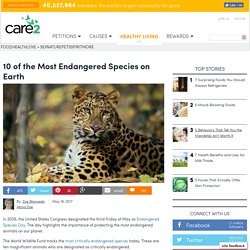
The day highlights the importance of protecting the most endangered animals on our planet. The World Wildlife Fund tracks the most critically endangered species today. These are ten magnificent animals who are designated as critically endangered. Related: How You Can Help Protect the World’s Wildlife 1. Unlike its southern cousins, the Amur leopard has adapted to live in the cold, temperate forests of southeast Russia and northeast China. With such a low population, a distinct threat to their survival is inbreeding. 2. This orangutan is native to the island of Borneo in the South Pacific.
Image credit: By Julie Langford, via Wikimedia Commons. Don't Let The Trump Administration Destroy The Endangered Species Act. On May 19, we celebrate Endangered Species Day, but this year the Endangered Species Act (ESA) itself could become endangered.
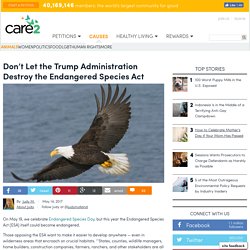
Those opposing the ESA want to make it easier to develop anywhere — even in wilderness areas that encroach on crucial habitats. “‘States, counties, wildlife managers, home builders, construction companies, farmers, ranchers, and other stakeholders are all making it clear that the Endangered Species Act is not working today,’” said Senator John Barrasso (R- Wyoming), as quoted by the Los Angeles Times. Barrasso is among the western Republicans who would like to turn federal land over to state control, supposedly because the states know best. Horseshoe Crabs Save Our Lives, So Let's Save Theirs Back. Horseshoe crabs have been around for over 450 million years, yet they’ve turned out to be a present day miracle for modern medicine.
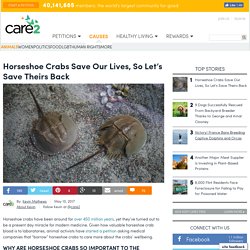
Given how valuable horseshoe crab blood is to laboratories, animal activists have started a petition asking medical companies that “borrow” horseshoe crabs to care more about the crabs’ wellbeing. Why are horseshoe crabs so important to the medical community? World's oceans facing biggest coral die-off in history, scientists warn. Scientists have confirmed the third-ever global bleaching of coral reefs is under way and warned it could see the biggest coral die-off in history.
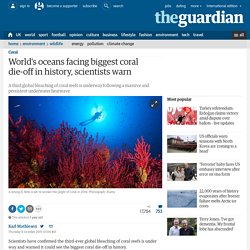
Since 2014, a massive underwater heatwave, driven by climate change, has caused corals to lose their brilliance and die in every ocean. By the end of this year 38% of the world’s reefs will have been affected. About 5% will have died forever. But with a very strong El Niño driving record global temperatures and a huge patch of hot water, known as “the Blob”, hanging obstinately in the north-western Pacific, things look far worse again for 2016. NC mussel, in trouble, could get federal protection - News - Wilmington Star News - Wilmington, NC. The yellow lance’s population range has declined 57 percent in recent years, prompting federal regulators to propose designating it as threatened By Adam Wagner StarNews Staff RALEIGH -- A freshwater mussel native to North Carolina could soon be designated as a threatened species, according to the U.S.

Fish and Wildlife Service. The federal agency has proposed the yellow lance mussel, which is found in the Neuse and Tar river basins, be listed as a threatened species under the Endangered Species Act. A threatened species is one that could become endangered -- or at risk of extinction -- in the near future.
Fish and Wildlife research indicates the yellow lance mussel’s range has declined 57 percent. Greg Cope, a N.C. “Mussels have really taken it hard because of all the development that we’ve undergone here in this state,” Cope said. The N.C. In 2014, the wildlife commission started working with N.C. Cope, the N.C. In one study, he worked with the N.C. En 25 ans, la Terre a vu disparaitre 10% de ses espaces sauvages. These Pangolins Are The Most Magical Things You'll See All Day.
Will These 'Walking Fish' Destroy Australian Ecosystems? We hear a lot about invasive species, but rarely does one make this big a splash.
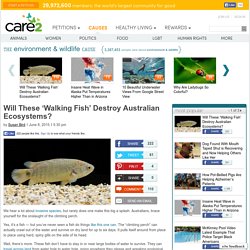
Australians, brace yourself for the onslaught of the climbing perch. Yes, it’s a fish — but you’ve never seen a fish do things like this one can. Nature Alert - Participez! Climate change could drive 1-in-6 species to extinction. Cranking up the planetary heat is going to ratchet down the planet’s biodiversity, and new analysis suggests global warming could directly threaten 1-in-6 species with extinction if polluting practices continue unabated — up from about 3 percent today. Scientists triggered alarm in 2004 when they warned in the journal Nature that climate change could drive 1 million varieties of plants and animals to extinction, but that was a rough estimate.
In the decade since, researchers worldwide have been probing the dangers that could face individual species as climate change causes their ideal habitats to shift around them. Those studies are collectively revealing a strong relationship between the amount of climate pollution that human activity pumps into the atmosphere, and the number of extinctions it’s ultimately projected to cause. Vulnerable species are either expected to relocate too slowly as their ideal ranges morph and shrink or they’re expected to have no place to go.
Biodiversité, état des sols, pollution : l'environnement se dégrade en Europe. La biodiversité va mal : si l'on veut un futur soutenable, il faut agir avec force. Delphine Batho, ministre de l'Environnement, lors d'une conférence environnementale, le 15 septembre 2012 (WITT/SIPA). Newsletter-summer-2014.pdf. « Jamais la condition des animaux n'a été aussi misérable » Le Monde.fr | • Mis à jour le | Par corine pelluchon (Professeure de philosophie à l’université de Franche-Comté) Les fêtes de fin d’année ne sont guère réjouissantes pour les oies et les canards mulards qui, pendant trois semaines, doivent ingurgiter deux fois par jour 450 grammes de nourriture en quelques secondes afin que leur foie atteigne dix fois son volume normal.
ASPAS : Association pour la Protection des Animaux Sauvages. How the threat to lions, leopards and wolves endangers us all. They are the planet's most prolific killers – and also some of nature's most effective protectors. This is the stark conclusion of an international report that argues that lions, wolves, pumas, lynxes and other major carnivores play key roles in keeping ecosystems in balance. It also warns that the current depletion of numbers of major predators threatens to cause serious ecological problems across the globe. The paper, written by a group of 14 leading ecologists and biologists from the US, Europe and Australia and published in the journal Science, calls for the establishment of an international initiative to conserve large carnivores and help them to coexist with humans. Failure to protect our top predators could soon have devastating consequences, they warn.
"Globally, we are losing our large carnivores," said William Ripple, the report's lead author. "Local bird populations go down because they have fewer berries to eat," added Ripple. Nor is the impact confined to land. Cats Dissected at California High School. In June of this year, students at Newport Harbor High School in Orange County, California posted photos on Facebook of cat dissection in anatomy class. They were not scientific photographs for learning you would expect in a classroom. Students were seen posing and smiling with mutilated cats. Videos were made and posted on Facebook. One showed a girl holding up the headless cat carcass, smiling and sticking out her tongue toward the cat.
This elicited a student comment “Ewwww … u look like ur trying to lick it.” Le Brésil s’apprête à cloner des animaux en voie d’extinction. Photos - Bornéo : un orang-outan sauvé après avoir été criblé de 104 plombs de chasse. The McDonaldization of Life on Earth. The “McDonaldization” of the world continues apace. It’s not just that the golden arches’ fries and burgers can be found in any country. According to Anthony Barnosky, a palaeobiologist at the University of California, Berkeley, a “McDonaldization of nature” is going on right now. While it is the case that, as a BBC report says, extinction is “actually a natural and common phenomenon” – some 99 percent of the estimated 4 billion species that have evolved on Earth are gone — Barnofsky emphasizes that extinction caused by humans is happening at an accelerated pace that is 1,000 times the natural rate. Newsletter-fall-2012.pdf (Objet application/pdf)
Biodiversité : les entreprises européennes s'en moquent par nature. C’est bien « l’ampleur de l’indifférence » qui frappe dans l’étude sur les entreprises et la protection de la biodiversité publiée le 16 octobre. Appel à soutien - Jane Goodall demande à Air France de cesser de transporter des singes pour les laboratoires sur Newmanity. In France, Dogs Are Dumped When Locals Go on Vacation.
Wild Animals Poisoned in Zimbabwe. Rio+20 Red List Identifies 63,837 Threatened Species. Oil Sands Moving Caribou Out Of Their Boreal Habitat. 7 adorable animals imperiled by the Keystone XL pipeline. PARIS - L' clairage public, une ombre au tableau pour la biodiversit. Photos - Le serpent le plus rare du monde re-découvert. Deux créatures rarissimes repérées dans un lac au Mexique. Private Landowners May Be Forced to Kill Prairie Dogs.